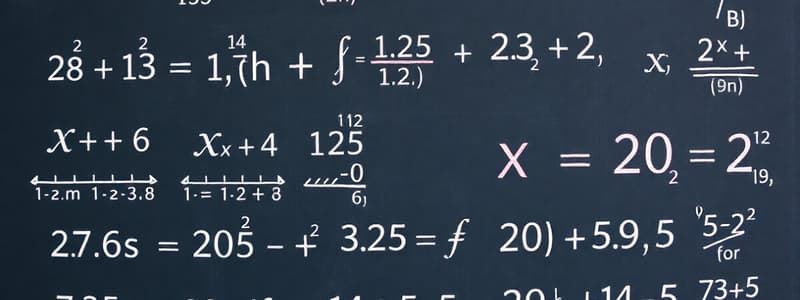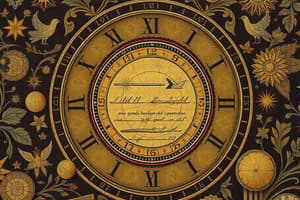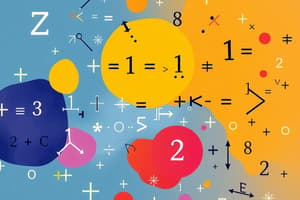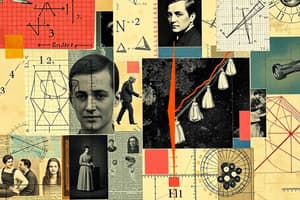Podcast
Questions and Answers
What do derivatives primarily measure in calculus?
What do derivatives primarily measure in calculus?
- Total area under curves
- Instantaneous rates of change (correct)
- Accumulated change in a dataset
- The spread of data in a dataset
Which measure describes the spread of data?
Which measure describes the spread of data?
- Mode
- Variance (correct)
- Mean
- Median
What is the fundamental theorem of calculus primarily concerned with?
What is the fundamental theorem of calculus primarily concerned with?
- The relationship between differentiation and integration (correct)
- Finding limits of a function
- Organizing statistical data
- Calculating measures of central tendency
In probability, what does it measure?
In probability, what does it measure?
What is an essential step in mathematical problem-solving?
What is an essential step in mathematical problem-solving?
Which number sets include zero?
Which number sets include zero?
What is the main focus of algebra?
What is the main focus of algebra?
Which of the following best describes the concept of irrational numbers?
Which of the following best describes the concept of irrational numbers?
What does calculus primarily study?
What does calculus primarily study?
Which statement is true regarding complex numbers?
Which statement is true regarding complex numbers?
What distinguishes quadratic equations from linear equations?
What distinguishes quadratic equations from linear equations?
Which of the following best describes a polygon?
Which of the following best describes a polygon?
What is the study of statistics concerned with?
What is the study of statistics concerned with?
Flashcards
Calculus
Calculus
The branch of mathematics that studies continuous change using derivatives and integrals.
Derivative
Derivative
Measures the instantaneous rate of change of a function.
Integral
Integral
Determines the accumulated change of a function over an interval or the area under a curve.
Function
Function
Signup and view all the flashcards
Limit
Limit
Signup and view all the flashcards
What is mathematics?
What is mathematics?
Signup and view all the flashcards
What are rational numbers?
What are rational numbers?
Signup and view all the flashcards
What are irrational numbers?
What are irrational numbers?
Signup and view all the flashcards
What is a variable?
What is a variable?
Signup and view all the flashcards
What is an equation?
What is an equation?
Signup and view all the flashcards
What is a polygon?
What is a polygon?
Signup and view all the flashcards
What is Euclidean geometry?
What is Euclidean geometry?
Signup and view all the flashcards
What is statistics?
What is statistics?
Signup and view all the flashcards
Study Notes
Fundamental Concepts
- Mathematics studies quantity, structure, space, and change, using symbolic language.
- It encompasses arithmetic, algebra, geometry, calculus, and statistics.
- Arithmetic involves basic operations (addition, subtraction, multiplication, division).
- Algebra uses symbols for unknowns, creating equations and inequalities.
- Geometry examines shapes, sizes, and positions.
- Calculus deals with continuous change and motion (derivatives, integrals).
- Statistics involves collecting, organizing, analyzing, and interpreting data.
Number Systems
- Natural numbers are positive integers (1, 2, 3...).
- Whole numbers include zero and positive integers.
- Integers are whole numbers and their negative counterparts (...-3, -2, -1, 0, 1, 2, 3...).
- Rational numbers are expressible as p/q (p and q are integers, q ≠ 0). Examples include 1/2, -3/4, 5.
- Irrational numbers cannot be written as a fraction of two integers. Examples include √2, π, and e.
- Real numbers combine rational and irrational numbers.
- Imaginary numbers, when squared, yield negative real numbers (involve 'i', where i² = -1).
- Complex numbers are a combination of real and imaginary numbers (a + bi, where a and b are real).
Algebra
- Variables represent unknown quantities.
- Equations show two expressions are equal.
- Inequalities show relationships of greater than, less than, or equal to.
- Linear equations graph as straight lines.
- Quadratic equations have a variable raised to the second power.
- Polynomials are expressions with variables and coefficients.
- Factoring expresses a polynomial as a product of simpler polynomials.
Geometry
- Points, lines, and planes are fundamental concepts.
- Angles are formed by two rays with a common endpoint.
- Polygons are closed shapes with straight sides. Triangles, quadrilaterals, and circles are examples.
- Geometric shapes have mathematical properties and relationships.
- Euclidean geometry is based on axioms and postulates about points, lines, and planes.
- Coordinate geometry uses coordinate systems to describe geometric figures.
Calculus
- Derivatives measure instantaneous rates of change.
- Integrals determine accumulated change or areas under curves.
- Functions assign inputs to outputs.
- Limits describe function behavior as input approaches a value.
- Differentiation and integration connect through the fundamental theorem of calculus.
- Calculus has applications in physics, engineering, and economics.
Statistics
- Data collection, organization, and presentation are key in statistics.
- Measures of central tendency (mean, median, mode) describe typical values.
- Measures of dispersion (range, variance, standard deviation) show data spread.
- Probability studies the likelihood of events.
- Statistical inference uses sample data to predict about a larger population.
Problem Solving
- Problem-solving involves identifying the problem, planning a solution, implementing it, and evaluating the result.
- Mathematical reasoning uses logic and arguments to prove or disprove ideas.
- Abstract reasoning allows manipulation and exploration of mathematical concepts.
Studying That Suits You
Use AI to generate personalized quizzes and flashcards to suit your learning preferences.




